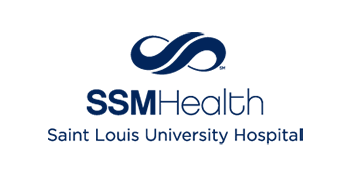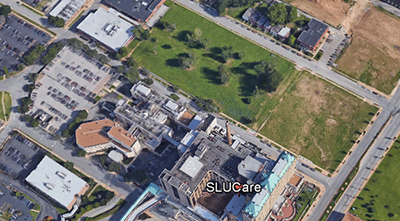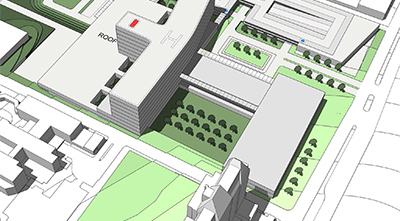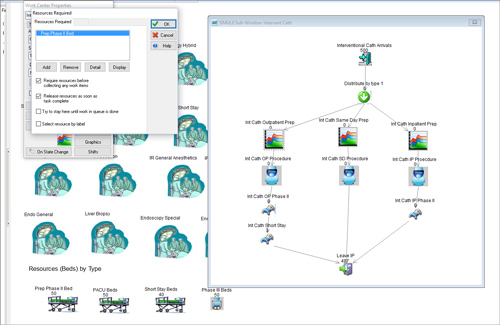Simulating an interventional platform concept at SSM Health Saint Louis University Hospital

- Industry
- Healthcare
- Location
- Missouri, United States
- Goals
- Make planning decisions for its campus renewal project using interventional platform concept
Achievements with Simul8
-
-
Minimized duplication of services and unnecessary patient movement whilst improving efficiency
-
-
Achieved solutions that would work for each component of the complex through simulation
-
-
Built confidence around decision-making for the interventional platform ahead of the new facility completion in 2020
About the project
In 2015, Saint Louis University Hospital was acquired by SSM Health System under an agreement that a new hospital facility would be developed within a five-year time frame, starting in 2017.
Frank Zilm, Chester Dean Director of the Institute for Health and Wellness Design, was selected along with four other leading firms to drive the planning phase of Saint Louis University Hospital’s $550 million renewal project.
The team recommended the use of an interventional platform, integrating surgery, cardiac, interventional radiology, and endoscopy services, to achieve a more efficient and flexible healthcare campus that will be capable of coping with future demands.
Although this new facility offered SSM Health an opportunity to revolutionize the way that future healthcare services are delivered, it was crucial that any operational and organizational changes could be fully evaluated to ensure physician and staff confidence in the plans.
With less than three months available to complete the planning and programming of the entire complex, Simul8 healthcare simulation software enabled rapid and thorough testing of the interventional platform, allowing for the impact of strategic decisions to be known.


"The idea of an interventional platform is to get maximum utilization of the resources, by positioning things in a way that you can deal with adaptation and change over time."
Chester Dean Director, Institute for Health and Wellness Design

Benefits of an interventional platform
A traditional model for a healthcare facility comprises multiple components that are involved in direct intervention with patients. For example, a surgery suite is an independent component which would consist of operating rooms, support areas and typically, a patient prep and recovery area for discharge patients.
This model has been favored within healthcare systems in the past as it allows for a greater degree of control over the performance of each component. However, despite its advantages, in the last decade an increasing number of hospitals have moved towards an interventional platform model.

Current SSM Health Saint Louis University Hospital campus
Integrating inpatient and outpatient surgery, cardiac procedures, interventional radiology, and endoscopy services in a central location, this approach minimizes duplication of services and unnecessary patient movement, whilst improving efficiency and patient outcomes.
When designing modern healthcare facilities, such as those at Saint Louis University Hospital, an interventional platform model offers a greater level of space utilization and flexibility through the use of common room sizes where the function can be adjusted.

Future SSM Health Saint Louis University Hospital campus


"The challenge that we had was to bring to the table possible new operational and organizational models for Saint Louis University to look at and provide the users, team and leadership with sufficient information and time to make good decisions. Not all new ideas are appropriate, but we wanted to make sure that ideas were explored and presented in a way that there could be careful evaluation and consideration of them."
Chester Dean Director, Institute for Health and Wellness Design

How was Simul8 used?
Evaluating an interventional platform's resource requirements with simulation
To verify the space and bed requirements of an interventional platform at Saint Louis University Hospital's new facilities, the team turned to Simul8 healthcare simulation software to simulate and test the complex patient flows and service processes involved.
Simul8 provided the flexibility needed to quickly make any changes to the individual components within interventional platform model, with each having a dedicated sub-window within the overall simulation.
Beds were modeled within the simulation as a resource and different bed types were allocated at relevant stages of the patient’s progress. Bed resource types included:
- Post-anesthesia care unit (PACU) - typically an open bay area
- Phase two – for patients requiring a lower level of observation and set up within individual rooms
- Phase three – a recliner area for patients with minimal anesthetics
- Short-stay beds – comprising of a 23-hour observational unit
In the patient arrival area of the simulation, patients were randomly allocated based on the probabilities of being an outpatient, inpatient or same day patient using Simul8’s distribution functionality.
The patients would then follow a certain route, based on flow of the different types of patient procedures that will be managed within the interventional model.
Variability was also added to procedure times, scheduling of patient arrival times, distribution of patients and the length of stay in different locations within pre and post areas, to better reflect real life conditions.

SSM Health Saint Louis University Hospital interventional simulation


"Before we used simulation, it made people really nervous to say, ‘Are we building PACUs and pre- and post-op areas correctly?’ - but once we showed the work groups the results of the simulation models and how we came to these, our physicians and staff felt more comfortable. It was a great process for us to go through and it really made a huge difference in our own confidence about how we were sizing the space and where we were putting our beds, resources, etc."
Vice President, Special Projects, SSM Health

Getting results with Simul8
Building stakeholder confidence for new healthcare concepts with simulation
The initial results from the simulation revealed the need for 40 phase two areas, 11 PACU, 14 phase three areas and 16 short-stays. Some results surprised the team compared to initial estimates, particularly the PACU numbers, estimated at 20, as well as the number of short-stay beds, estimated at 10.
"This number of short-stay beds was interesting because I really do think it was reflecting some forward-thinking by everybody involved about how care will be provided in the future. This was a bigger number than we had anticipated, but I think it really reflects a shift in care that is an appropriate assumption about how to work in the future." - Frank Zilm, Chester Dean Director, Institute for Health and Wellness Design
From the initial simulation results, a sensitivity analysis was undertaken using healthcare simulation software to test a range of 'what if' scenarios. All of these findings were reviewed again with each service component and any minor adjustments were made.
The optimized simulation and results were presented to the leadership team within the three month period and accepted with little hesitation, as Frank explains:
"The key thing is people understood how we attacked the problem, how we approached it, how we analyzed it, what the simulation models were saying, and then what adjustments we were making." - Frank Zilm, Chester Dean Director, Institute for Health and Wellness Design
Simul8 provided SSM Health with a flexible, risk free environment in which physicians and staff could provide input and recommendations throughout the process to achieve a solution that would work for each component of the complex.
Through the discussions facilitated by using simulation as part of the project, as well as the results and evidence provided, SSM Health's leadership team have been able to build confidence around decision making for the interventional platform ahead of the new facility completion in 2020.
Webinar
Discover how simulation aided discussions and decisions for changing key hospital services delivery.
Watch webinar
Healthcare Resources
Explore our healthcare resources to learn how Simul8 can benefit your organization.
Learn more
Learn more about Simul8 for healthcare process improvement
Find out more about how simulation is used by healthcare organizations, read more case studies and access a range of learning resources.
Learn more